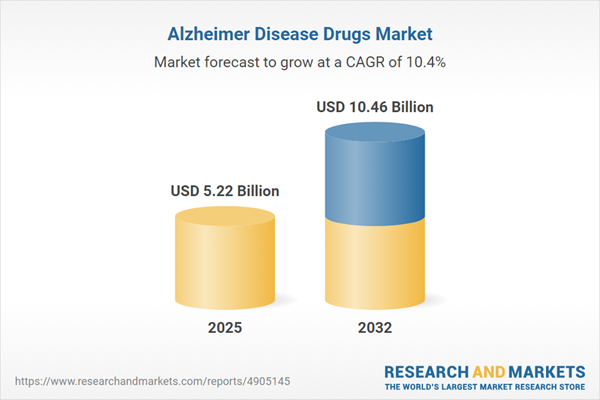Speak directly to the analyst to clarify any post sales queries you may have.
The Alzheimer’s Disease Drugs Market is undergoing a significant transformation, powered by ongoing scientific breakthroughs and heightened by evolving regulatory frameworks and demographic pressures. Senior decision-makers require actionable market intelligence to address shifting care demands, capitalize on innovative drug developments, and navigate new operational and policy complexities.
Market Snapshot: Alzheimer’s Disease Drugs Market Growth and Outlook
In 2024, the Alzheimer’s Disease Drugs Market achieved a total value of USD 4.74 billion, and forecasts indicate growth to USD 5.22 billion in 2025. This indicates a compound annual growth rate (CAGR) of 10.40%, leading to an expected value of USD 10.46 billion by 2032. Such expansion is propelled by the rising global incidence of Alzheimer’s, increased R&D initiatives, and a heightened focus on innovative treatment methods. Key players are driving market momentum by moving beyond symptomatic drugs toward disease-modifying options as stakeholders adapt to mounting demand for advanced solutions and evolving regulatory, clinical, and commercial dynamics worldwide.
Scope & Segmentation
This market analysis spans the full spectrum of product categories, stakeholder groups, and regional considerations, offering a holistic view tailored for informed strategic planning.
- Drug Class: Includes amyloid beta-targeting agents, such as amyloid beta antibodies and beta-secretase (BACE) inhibitors, as well as cholinesterase inhibitors and NMDA receptor antagonists. The expanded drug landscape reflects greater emphasis on mechanistic approaches in therapy development.
- Drug Type: Both branded and generic drugs are evaluated, reflecting competitive and pricing considerations across markets.
- Formulation: Covers injectables, including intravenous infusion and subcutaneous injection, alongside oral forms like capsules and tablets—meeting diverse patient and provider preferences.
- Distribution Channel: Hospital, retail, and online pharmacies are all examined, demonstrating shifting trends in drug accessibility and patient purchasing behaviors.
- End User: Major end users include clinics, homecare providers, and hospitals, highlighting the broadening scope of Alzheimer’s care outside traditional clinical settings.
- Region: Geographic coverage includes Americas (North America and Latin America), Europe, Middle East & Africa, and Asia-Pacific, with country-level detail such as United States, Canada, Brazil, United Kingdom, Germany, China, Japan, India, and others. Each region reflects distinct regulatory environments, care models, and growth drivers in the Alzheimer’s drugs market.
- Leading Companies: Features companies advancing both research and market presence, including Eisai Co., Ltd., AbbVie Inc., Novartis AG, Johnson & Johnson, Biogen Inc., Eli Lilly and Company, Teva Pharmaceutical Industries Ltd., Sandoz International GmbH, Viatris Inc., and Apotex Inc.
Key Takeaways for Senior Decision-Makers
- Therapeutic approaches in Alzheimer’s are increasingly focusing on disease modification, with innovators leveraging mechanisms like immunotherapy and biomarker-driven strategies.
- Adoption of digital health platforms and integration of cutting-edge biomarker tools are improving early diagnosis and enabling personalized care pathways.
- Collaboration among pharmaceutical companies, biotech firms, and academic centers is accelerating clinical development, regulatory validation, and broader market entry of next-generation therapies.
- Adaptive regulatory policies, including expedited approval pathways and real-world data expectations, require organizations to maintain operational flexibility and engage proactively with policy developments.
- Regional differences shape market strategies: Americas emphasize data-driven patient recruitment, EMEA focuses on stringent evidence criteria, while Asia-Pacific leads in new reimbursement strategies and technology adoption.
Tariff Impact: Navigating 2025 U.S. Pharmaceutical Trade Changes
The introduction of new U.S. tariffs on pharmaceutical imports in 2025 has prompted Alzheimer’s drug manufacturers to confront increased sourcing costs and supply chain complexities. In response, many organizations are reassessing manufacturing locations, streamlining supplier networks, and exploring nearshoring options. Companies are also re-evaluating pricing and distribution models to safeguard patient access in cost-sensitive systems, making operational resilience a central focus amid ongoing innovation efforts and evolving trade conditions.
Methodology & Data Sources
This report employs a rigorous methodology, combining extensive expert interviews with systematic literature reviews and secondary data validation. Insights from neuroscientists, regulatory professionals, and industry executives are harmonized with peer-reviewed research and public regulatory filings, ensuring a comprehensive and reliable intelligence base for strategic decision-making.
Why This Report Matters
- Arms decision-makers with actionable intelligence to anticipate key inflection points in research, operations, and market entry planning.
- Clarifies the technological and policy shifts necessary to achieve competitive positioning as the Alzheimer’s Disease Drugs Market evolves.
- Facilitates evidence-based decisions for investment, strategic collaboration, and risk management, addressing challenges created by dynamic global trends.
Conclusion
The Alzheimer’s Disease Drugs Market is defined by rapid scientific, regulatory, and commercial evolution. Stakeholders equipped with robust insights will be positioned to advance new therapies and improve patient outcomes worldwide.
Additional Product Information:
- Purchase of this report includes 1 year online access with quarterly updates.
- This report can be updated on request. Please contact our Customer Experience team using the Ask a Question widget on our website.
Table of Contents
3. Executive Summary
4. Market Overview
7. Cumulative Impact of Artificial Intelligence 2025
List of Figures
Samples

LOADING...
Companies Mentioned
The key companies profiled in this Alzheimer's Disease Drugs market report include:- Eisai Co., Ltd.
- AbbVie Inc.
- Novartis AG
- Johnson & Johnson
- Biogen Inc.
- Eli Lilly and Company
- Teva Pharmaceutical Industries Ltd.
- Sandoz International GmbH
- Viatris Inc.
- Apotex Inc.
Table Information
| Report Attribute | Details |
|---|---|
| No. of Pages | 188 |
| Published | October 2025 |
| Forecast Period | 2025 - 2032 |
| Estimated Market Value ( USD | $ 5.22 Billion |
| Forecasted Market Value ( USD | $ 10.46 Billion |
| Compound Annual Growth Rate | 10.4% |
| Regions Covered | Global |
| No. of Companies Mentioned | 11 |









